~mike gradziel.
to the index page
Dawn came over northern Canada but the windows were shut and my luxurious business-class seat (thanks, frequent flyer miles!) was a comfortable bed courtesy of the half-dozen electric motors and drive mechanisms that Lufthansa installed complete with a controller sporting as many buttons as a television remote. Rested, I awoke over Germany where the late afternoon sun cast a warm glow over rolling green hills and neat canals. For some reason I couldn't help but imagine I was on a bombing run in a WWII airplane. This notion persisted as I gazed down on the serene landscape and munched elegant plates of food brought by attentive waitstaff.. my first venture into mainland Europe was informed mainly by history studies. In Munich people were drinking beer and eating sausages and potatoes - for breakfast? No, it was evening - and a new plane was about to whisk Joy and me over the alps, away from peaceful green country and into parched dry Italian chaos. Our taxi in Naples raced through red lights and passed passing cars and careened down an alley in reverse. Our room was bare and poor. We fled south at first light, going by train to a seaside paradise complete with an old stone castle and bright turquoise water; next we arrived in the southernmost part of Italy to celebrate the marriage of friends Ivan and Domenica in the fine Italian tradition of a nice ceremony in a church by the sea, followed by an extravagant dinner lasting five hours through countless courses of food no person could eat complete. Across the straits in Sicily, lava poured from Mount Etna glowing red in the night like a distant forest fire. Our travels then took us into rural hill towns little changed since medieval architects laid out narrow streets two donkeys wide. Olive trees blanketed the hills and restaurants and shops were few. Wonderful aromas of cooking food tempted us through open windows; tomatoes and peppers straight from the tilled land were being prepared just out of our reach. Days later while drowning in the commerce of Italy's popular Amalfi Coast I longed for an empty mountain hamlet. The beaches were nice, though, and in Pompeii I learned from the 2000 year old ruins how I should build my domed brick oven when some day I have a back yard of my own. My favorite pizza in Naples was basically a tomato-sauce topping covered with a caprese salad after baking. Back home after two weeks, I'm craving rice but anxious to try out some new pasta sauces when the rice phase passes.
Click photos for enlargements.
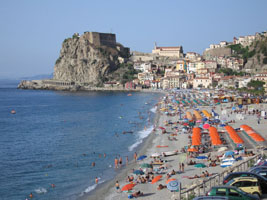
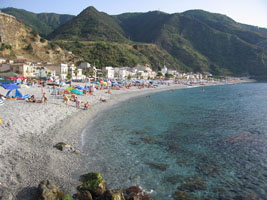
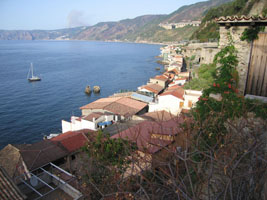
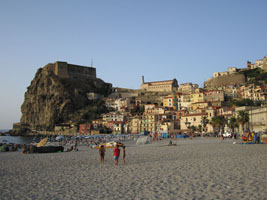
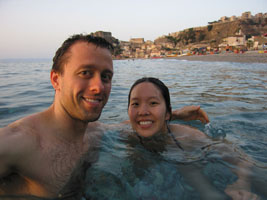
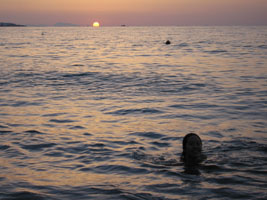
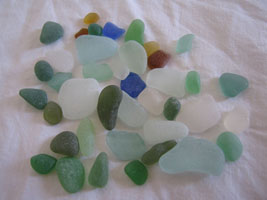
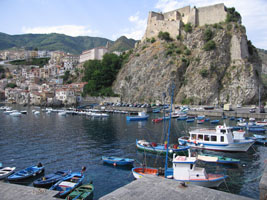
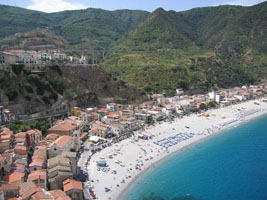
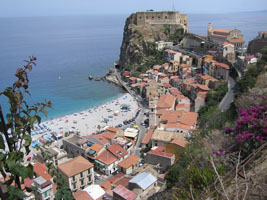
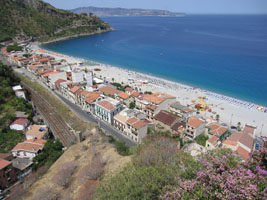
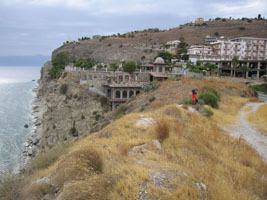
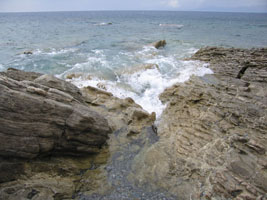
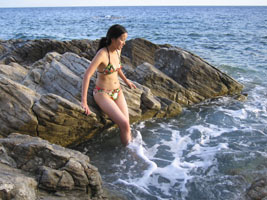
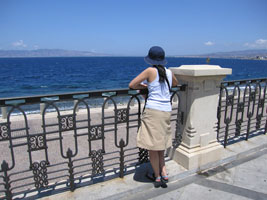
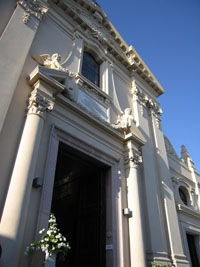
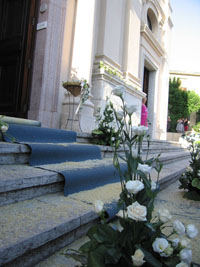
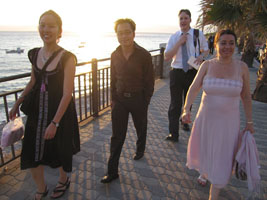
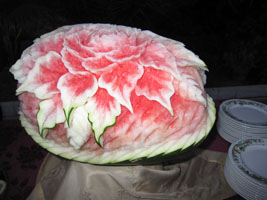
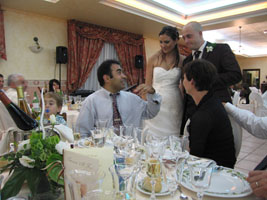
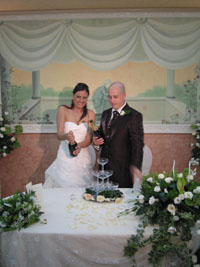
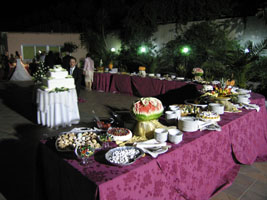
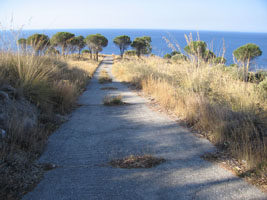
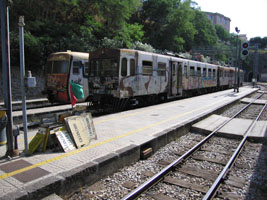
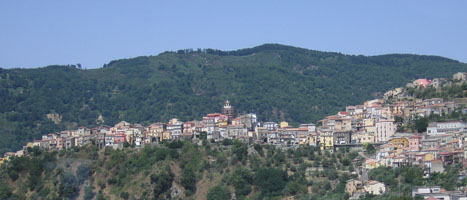
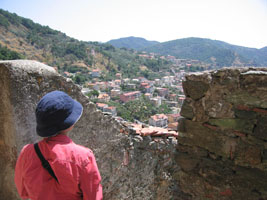
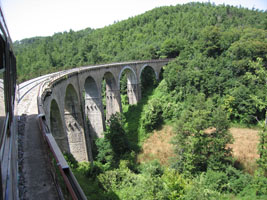
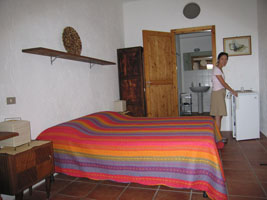
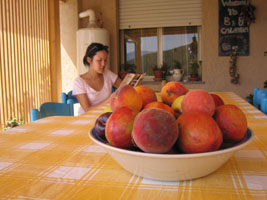
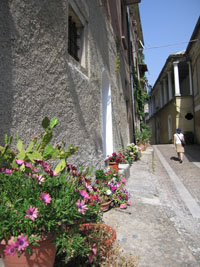
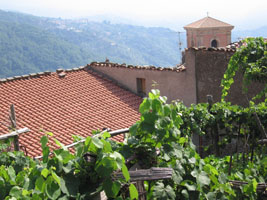
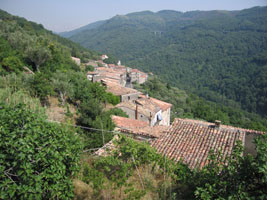
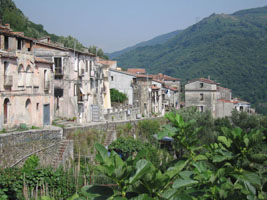
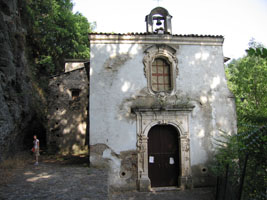
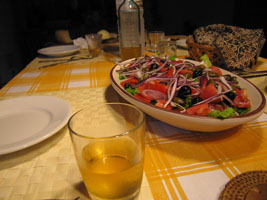
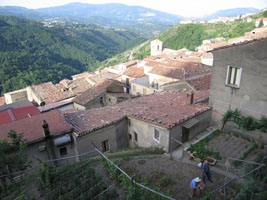
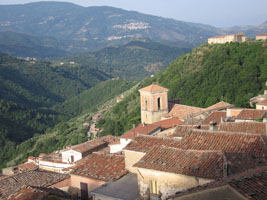
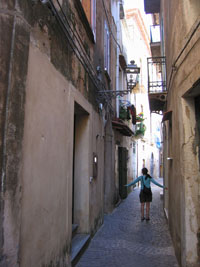
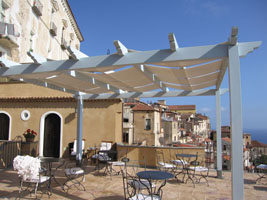
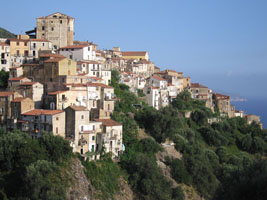
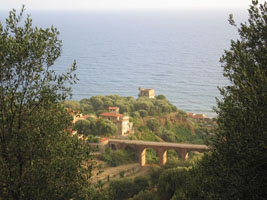
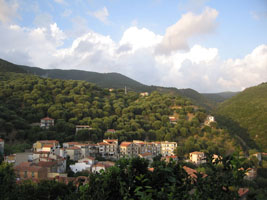
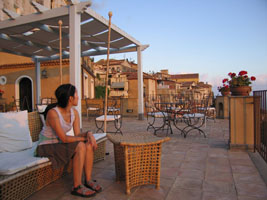
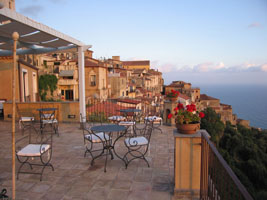
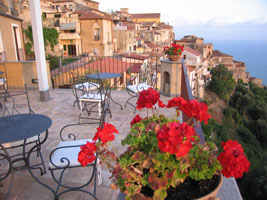
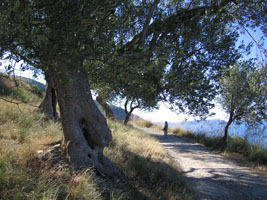
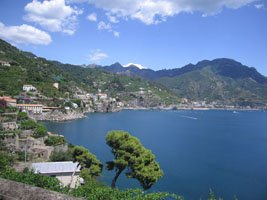
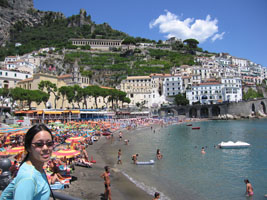
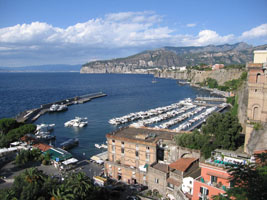
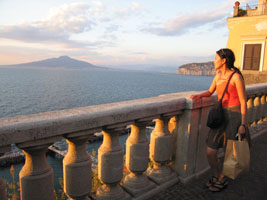
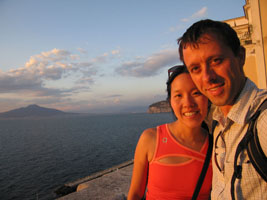
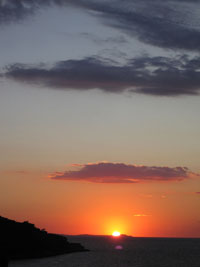
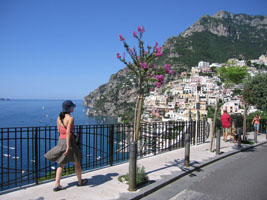
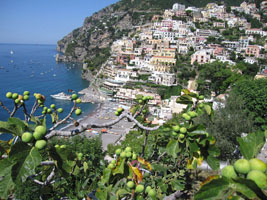
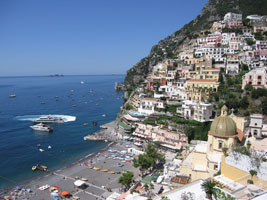
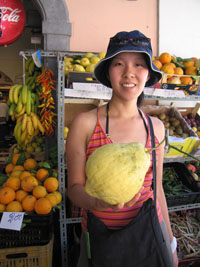
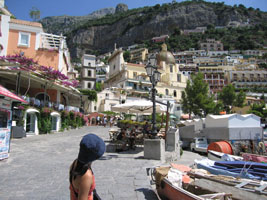
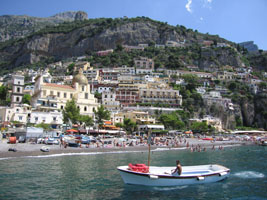
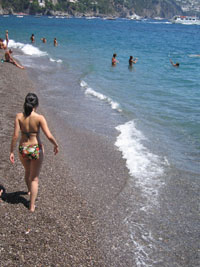
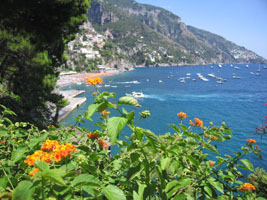
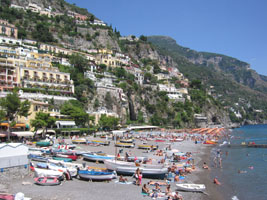
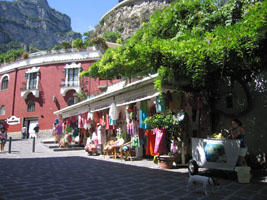
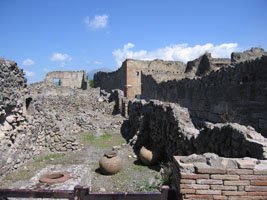
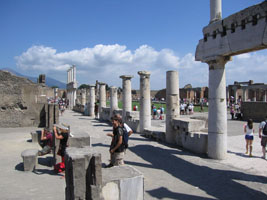
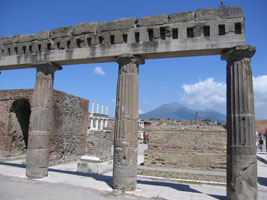
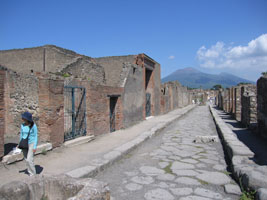
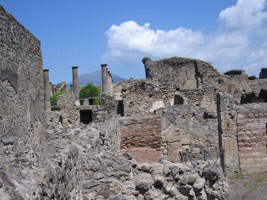
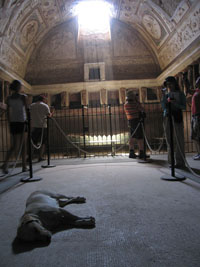
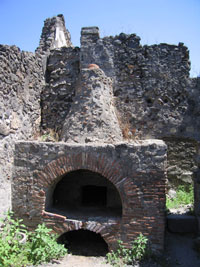
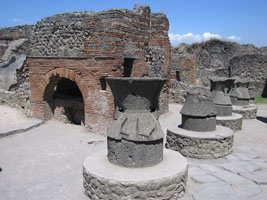
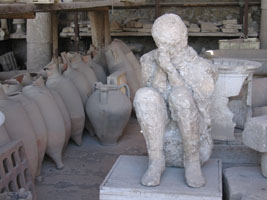
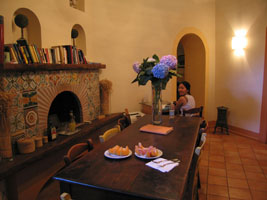
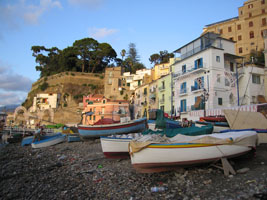
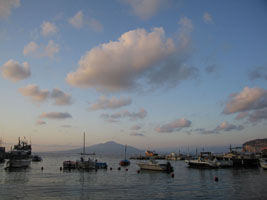
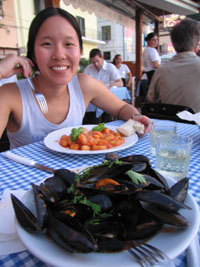
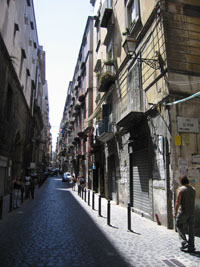
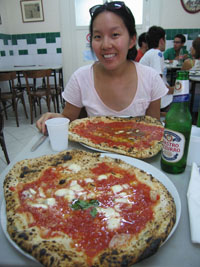
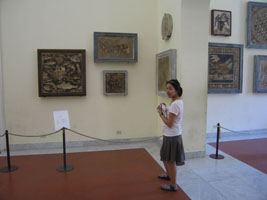
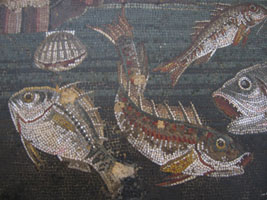
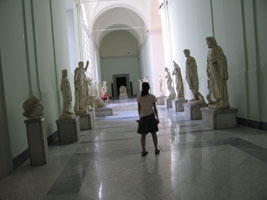
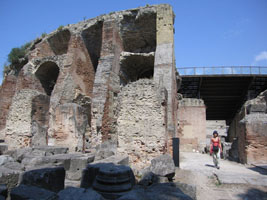
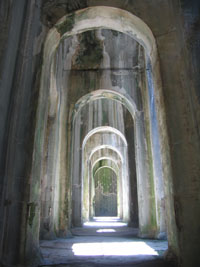
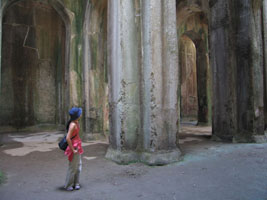
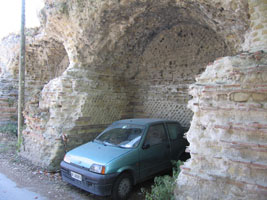
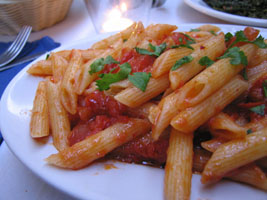
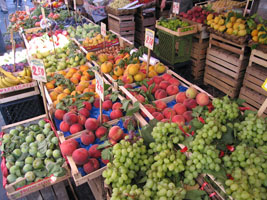
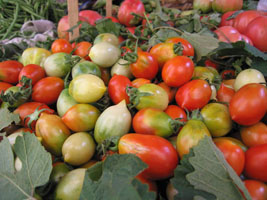
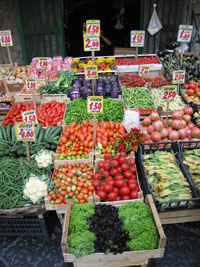
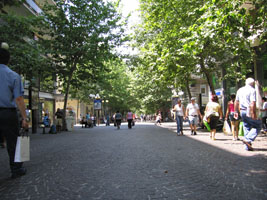
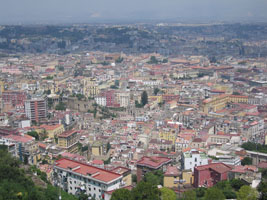
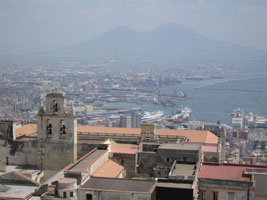
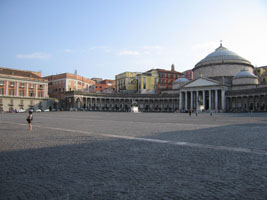
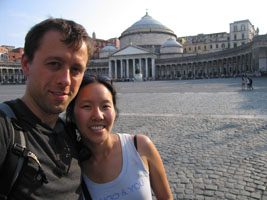
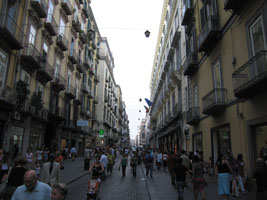
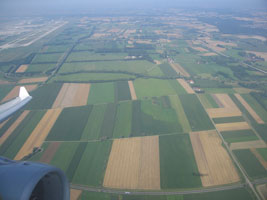
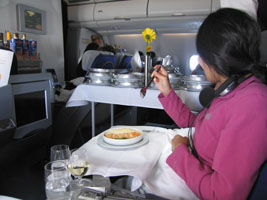
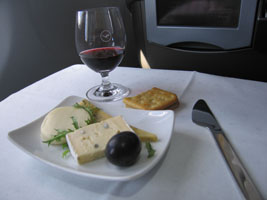
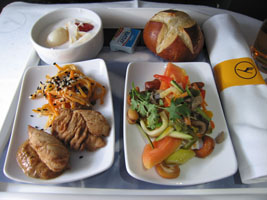
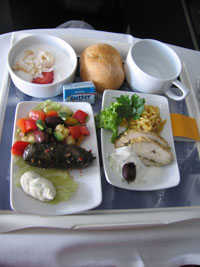
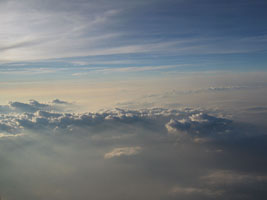
Cutting across the sea from the Alps toward Africa is a ragged dry peninsula. Poor and colorful, in some ways it is to Europe what Mexico is to North America. The source of a distinctive cuisine made popular by a vast surge of immigrants to foreign lands, Italy has often suffered under foreign rule and still today it struggles to maintain obedience among its citizens to even the most basic traffic laws. Also like Mexico, Italy has a long history of grand civilizations and even today there is something very appealing about this arid land surrounded by as azure seas, where old ways capture our imagination.
In a church by the sea across from Sicily in July 2008 Ivan and Dominica would be married. Though the euro was buying just two thirds of a dollar and my spacecraft mechanism job for NASA was begging for extra work, Joy and I set out to attend the wedding and this see the south of Italy in a two-week tour by train. We watched the red glow of lava pouring from Mount Etna at night, swam in the sea at sunset beside a medieval castle and its adjoining fishing village, explored rural hilltop hamlets, visited Pompeii, and enjoyed a great deal of wonderful food.
It started one blazing hot day after work when I left my apartment and walked to the Pasadena train station carrying a green canvas rucksack with a two-piece suit rolled up inside. At the Los Angeles Airport Joy was already waiting in a plush international lounge, having flown in from San Francisco, when I arrived. Over three years of flying to see each other and yielded frequent-flier tickets to Naples via Munich, business-class. I had trouble finding the priority security screening because there was no line! It was such a cushy place and not even first-class. We snacked on complementary food and cold beer, then boarded our plane and eased into luxurious seats each sporting half a dozen electric motors to adjust the tilt in shape for maximum comfort - even massage!
There were macadamia nuts for snacks instead of peanuts, our tray tables were set with pressed white cloths, and gourmet meals were served from a cart adorned with fresh flowers. I ate twists of smoked salmon with horseradish mascarpone and slivers of yellow pickled fennel arranged beside vivid purple potato medallions in a creamy dressing, a treat for the eyes! There were hot towels and cold drinks and later we made our seats almost flat for a good rest through the North Atlantic dawn.
Peering out at undulating green fields beneath popcorn clouds when I awoke over northwestern Germany, I couldn’t help but imagine that I was on a World War II bombing run over red roofed villages and small meandering canals. I studied so much history! Carpets of wildflowers lined the runway at Munich, and adorable airport with cute shops and cafes servings up hearty soups and dark bread. It was late afternoon. Business travelers sipped beers while we poured our orange juice. There were Italian olives too, fresh bright-green sweet summer olives I never see in stores. In the business lounge there were sleek computer workstations and nearby in crockpots, potatoes and sausages simmered. Outside the sun sank low in a pale blue sky looking just like an 18th -century painting.
Then suddenly the peaceful journey came tumbling to pieces. Our plane left Munich and crossed the Alps, passing the island-and studded coast of Croatia in distant haze and swooping into a pale gray valley bathed in moonlight. Traffic churned through hot dry air beneath the parched brown silhouette of Mount Vesuvius and trash littered dark cobblestone streets that our taxi driver entered at full speed in reverse, searching for our hostel in the night. There were crowds of people out and the noise once constant. In our room, the towels were as thin as table napkins.
Dawn revealed a calmer scene. The trash outside had disappeared and was replaced by a bustling marketplace where vendors were setting up stalls to sell shoes and handbags. By Joy’s careful planning the city train station was a short walk away. A train with grimy windows set out southbound at 9:42 a.m. to collect beachgoers on holiday. They got on and off at towns along the way where beach umbrellas were arranged in neat lines through the sand. We saw the blue water in a series of infrequent glimpses when the train shot out of one tunnel for a moment before burrowing into the adjacent hillside - the route seemed to be more tunnel than open track!
Olive trees clung to scrubby brown hills defiant of the drought with their dull green leaves. It was hot and I was hungry. At Lamezia station we ate sandwiches at a cafe and then rode another train on to the town of Scilla (“sheela”) where we disembarked onto a crumbling concrete platform smeared with graffiti. Beyond the neglected government railroad, the town was in better condition and just beyond was the gleaming sea! Our hostel was directly across the street. Finally, a place to put down the bags and throw open the terrace doors for a fresh breeze and a view of the deep blue water!
The tile floor was cool. The towels were soft and we napped two hours before following a short alley to the pebbly beach. The water was cool and pleasant, good for swimming but we continued on through ancient narrow streets. On the rocky headland was an ancient castle built by the Normans over a tumbling village of red roofs that swept down the soft green slopes and tucked into every hollow. At the hilltop we ate lemon and peach gelato, then hot and sticky we retreated to our room, changed into swimwear, and slipped into the cool water on the almost empty beach. Italians love the sun and leave when is sinks low, so it was calm and quiet on the beach as we floated on the clear lapping waves and watched the orange orb of the sun sink into the sea at the edge of Sicily.
Pockets heavy with pretty pebbles, we returned to our room and then went out for pizza (very cheap!). Later, we walked back to the castle entrance to admire twinkling lights from town shimmering on the water. A strong beam from the castle swept across the fringes of town on its arc across the sea, warning boats away.
In the morning I awoke at 5:30 a.m. and opened the balcony doors. Outside it was very quiet. The sea turned shades of pastel as the sun near the horizon. Large ships slipped past through the Straits of Messina; soon the sun beat down on empty sand outside and it was time to look for bits of smooth sea glass. Joy was unhappy that I was awake. The bed was soft and warm and in California it was some time of day not normally associated with waking up. We walked for an hour or so and I rescued a sea jelly that was still moving where it had been tossed ashore by a wave. I had never seen a jelly moving on the beach, pulsing like a beating heart.
On the hotel terrace we ate bread with jam and gulped steaming tea while the day grew hot. The castle was open for visitors so we paid a small fee went inside only to discover that a castle built on a rocky clifftop promontory is little more than a landscaped hill! There was no room inside the castle; it was solid rock with a courtyard on top. Attackers would see an imposing fortress towering 20 meters from its foundations, but its two small chambers could hardly have held an army. Below, brilliant turquoise water buoyed swimmers as if they were floating.
About the castle in the high part of town I found a boxed ice cream loaf with wafer thin layers of chocolate. Called a Vienetta, it is not sold in California. Ever since we ate one at dusk on a rooftop patio in Dunedin, New Zealand while spring rain clouds cleared over green hills streaked with yellow flowers, I have thought wistfully of finding such decadence once again - but in the hot Italian sunshine the quickly melting vanilla desert did not quite pass its second test, ending in a sticky mess and an unhappy stomach not helped by my drinking almost a liter of too-sweet bottled peach tea.
We sat on a bench overlooking the sea and watched ships pass, then descended to the beach by a grassy path under trees loaded with hundreds of unripe figs, lemons, and oranges. In the afternoon heat, still feeling the effects of our sugary lunch, I found the allure of Scilla fading fast. We checked out of our hostel and sat for a while on a sunny bench before deciding to catch an early train out of town. Through gritty windows the blue sea took on a muted gray hue. Our spirits were low. Early at the tiny train stop in Lazzaro, we had no ride downward and there were no taxis or buses. We sat on our bags in a scrap of shade for a while until Nick, the hotel manager’s son, arrived and excitedly drove us a few miles to the Hotel Paradiso.
Nick, who was about our age, spoke some English and drove carefully despite being a frenzied bundle of energy eager to please. He showed us to our room overlooking stone rooftops and the big blue sea. I unrolled my suit and fount the jacket and pants passable in an appearance but the cotton shirt hopelessly creased in a way that no amount of steaming near the shower or smoothing on the bed could correct. I ventured down to the lobby repeating in my mind the Italian word for “iron”. Surely enough, the shirt could be pressed, but it seemed as if they thought my request was unusual. Do all Italians travel with irons?
We went for a walk from our hotel down a steep rocky path to the bottom of the seaside cliffs where gray waves foamed on the rocks beneath a steely sky. A ray of sunlight was catching the steam rising across the straits from Mount Etna, a shadowy silhouette in the haze except for the golden plume being carried from its summit southwest with the wind. There was a brisk breeze and it seemed cool for swimming, a striking contrast to earlier in the day when swimming would have been so nice if only we had a room to leave our bags and change our clothes. Determined to swim, cold or not, I changed clothes back at the room, returned to the beach, and waded into the water. There were rocks and slimy plants and even some spiky urchins - it was not an ideal swimming spot. Joy stayed on shore.
Joy’s friends were back at their room next to ours when we returned. Later, around 9 p.m. we all gathered for dinner at a pizza place. The toppings were a little strange to me - thin strips of prosciutto ham laid across a pizza on barely melted cheese had to be cut with a knife or they would pull off in one piece at the first bite.
In the morning we enjoyed a breakfast of juice, tea ,croissants, bread, jam, cold cuts, and cheese on the hotel terrace overlooking the sea. The air was still pleasantly cool. Later we rode into Reggio Calabria with Joy’s friends. At the center of the city across the straits from Messina is a nice upscale shopping area and a pretty seaside walk. Most of the shops closed for siesta from 1 p.m. until 2:30 so we went back to the hotel to rest and work up an appetite for a big dinner - a huge dinner as it turned out; there was simply no way we could have eaten everything.
Italian weddings evidently are a show of wealth and excess; our evening unfolded through a long series of meals. But first, there was a lovely ceremony in an old church in Porto Melito di Salvo. We listened patiently to the readings and sermons in Italian, admired the frescoes on the ceiling, and threw rice when the happy couple emerged after the ceremony and hurried to their waiting limo for shelter from shower. They went away to take pictures and a little while later we went to a restaurant where the reception would be held.
On tables outside there was a sparse selection of fried antipasti - olive balls, cheese, and also champagne. Anticipating dinner next we munched and chatted until Ivan and Domenica arrived. They walked on through a balloon studded arch and untied a ribbon gate, opening the way for guests to join them at a lavish spread of antipasti. There were tens of meters of tables lined up around a courtyard covered with stacks of ripe figs with prosciutto ham, oysters and shrimp, puff pastries, melon balls, pasta dishes, and countless other appetizers. We ate and ate for a long while, admiring the ornamental carved squash and melons, but then doors opened and we were ushered inside where tables seat 200 people waited set with wine and flowers.
An army of tuxedo-clad waiters marched in and served shrimp salads, then returned to replace them with half-lobsters with linguine and red sauce, next a sort of white lasagna, then a layered casserole of pink and white fish with roasted prawns, a green salad, pink grapefruit sorbet, and a final course of steak and potatoes, and of course bread and wine. Then there was cake!
A monstrous white cake rolled in from the kitchen and the happy couple cut a piece; then the cake was taken away - outside! After champagne toasts by the couple and their families, we followed them out to the courtyard were a fantastic spread of desserts had been set. It was like looking at six or eight pastry counters from an upscale grocery store back home, all strung end-to-end and adorned with carved chocolate sculptures and watermelon flowers, and being able to eat anything we wanted! Being absolutely stuffed already didn’t help.
Across the straits, glowing red lava poured from Mount Etna into the black night. Stars shone overhead through breaks in the clouds. I munched on sweet figs and chocolate cakes and heaping plates of fresh berries - wild sweet juicy berries. There was far too much food, and more champagne, and waiters were everywhere to attend to our needs. We enjoyed what we could an wished Ivan and Domenica well as we departed in the early hours of the morning.
The sea and sky were bright blue when I woke. I walked back into golden grassy hills dotted with green trees. Across the water, the hazy outline of Mt. Etna produced a wisp of smoke. After breakfast Nick took us to the train station. There were no ticket sales there; everything was broken and run down, but we were able to get off the train (taking all our bags), buy tickets, and hurry back on while the train waited at the next stop. The train drivers know nothing about buying or selling tickets; they just drive the train when green lights indicate “go”. We were lucky there was a delay ahead on the tracks.
At the Catanzaro Lido station we waited a while for a ride we had arranged, eventually calling for a ride with text messages didn’t bring any response. We stayed for the night at a bed and breakfast run by Texan Cherrye and her Italian husband Pepe. Their website had look nice but the place was rather plain and bare and was a 45 minute walk out of town. Pepe told us when the hourly bus would stop to take us back to the waterfront, but we waited 20 minutes with no bus of any sort going by and descended to walk (no buses went by until 40 minutes after the scheduled time!). On the beach we sat for a while, drank sodas, and splashed in the water. Several African vendors came past selling sarongs and handbags. The water was very calm.
No restaurants were open until 8 p.m. The entire town seemed empty and worn out; graffiti covered every wall and there didn’t seem to be any hotels, though there were lots of people on the beach and waterfront promenade. For the third time in four nights we had pizza for dinner. Joy got a caprese pizza - no sauce, just olive oil on the crust and a topping of fresh tomato, basil, and mozzarella all added after baking and drizzled with olive oil. I had a Sicilian pizza with thinly sliced egg plant and tomato sauce. Both were good, but we hoped for no more pizza before Naples.
The late dinner left us with a somewhat scary 45 minute walk back to the bed and breakfast on lit but remote sidewalks and roadside. We evaded a stray dog that tailed us for a quarter mile by jumping a small wall and going around the back of a shopping center, where new hazards (mysterious cars and shadows) lurked. We made it back without incident, but our plain room in a dumpy town for 60 euros was awful compared to the 70 euro sea-view room we loved in beautiful Scilla!
Even worse, the wind rattled our windows all night long. That is typical - a wind turbine farm was perched on a nearby ridgetop. Breakfast was as plain as the rest of the place: plastic wrapped croissants. However, Pepe was nice - he drove us back into town so we could buy tickets for the train. The small train station just a short walk from the bed and breakfast was gutted and completely covered with graffiti, looking just like the train - colorful in a 1960s sort of way.
We had to work out a new schedule with the people at the station because our plans made from their website were out of date. No one really seemed to know the train system, simple though it was. Once under way we crossed high bridges that ended at tunnels - it is rugged country - and got off and Gimgiliano, a mountain hamlet where they are no restaurants because everyone cooks their own meals.
What wonderful smells drifted out open windows and doors as we explore the narrow medieval streets! But despite our searches and inquiries we could find nothing to buy, food or otherwise, except fresh fruit. The purple figures were fantastic! We ate them while sitting on a bench in the plaza. There were red bell peppers that looked exactly like tomatoes, except they lacked the proper weight. Everyone in town was watching us before long as we meandered around, our rolling luggage bumping along the cobbles.
Gimgiliano was a cute town, but there was little for us to do. We couldn’t find any shops selling local craft and we had become an attraction ourselves. We exited down a steep stairway past olive groves and fig trees. A small bus had brought us up to town by a long circuitous route necessary to avoid tight turns on the steep slope, but it was an easy walk down. We stopped in the shade and ate granola bars and cheese.
So started several idyllic days of traveling. The next train to took us into bright green low hills that reminded me of New England. We passed some fields of golden wheat and mixed crops of tomatoes, peppers, eggplant, and corn. There were orchards of fruit trees and fields of freshly baled hay and straw. The fields are irrigated though the forest is not particularly dry.
Joy sent a text message to Rafaele who was waiting to collect us from Scigliano station when we arrived. It would not have been a long walk, but the road was circuitous and winding. Rafaele and his Dutch wife Esther both speak good English and run a lovely bed and breakfast in one of the small medieval hamlets slanting across a densely forested hillside where a donkey path once ran. Our room was on the lower floor in a thick-walled masonry building behind a heavy short wood door that looked like the entrance to a hobbit house. It was like living in a castle with earthy tile and dark wood, but also white walls and a colorful red and yellow bedspread. Rafaele is an architect, evidently a good one.
The room was very cozy and our hosts were wonderful. Esther in particular loves to chat. She will make guests dinner for 10 euros each and we accepted - for a while there are some dining options in Scigliano they are not really restaurants, just mediocre cafes or bars. This was a new thing for me, being unable to buy anything in a town I’d traveled to. It was frustrating, but also rather nice to come upon such places where people are more or less content to keep their usual lifestyle and leave the visitors on their own.
Of course the situation isn’t all cheerful. Like many hill towns in Calabria, Scigliano is populated mostly by elderly Italians, for young people have left in search of work (and probably retail and restaurants to!). But the old white-haired men and women I saw in tending their backyard plots of land seemed to do quite well. Esther said most people had a pig around somewhere and while slaughtering was no longer allowed in one village home, they still did this - at night. The province of Calabria is known for it’s cured meats. Most homes had well-kept gardens of tomatoes, beans greens, and basil and I even saw more purple figs (I love figs).
We walked for two and a half hours past wild blackberry patches, grapevines, and fig trees. Later in the season one could live off the land! Of course these might not be properly called wild plants since the land has been cultivated since before Roman times. An old arched stone bridge built by the Romans is still standing just a few miles away, but we didn’t walk that far in our afternoon stroll. Instead we walked to a vacant cliffside church beside a gurgling mountain stream that plunged over several pretty waterfalls. Continuing on along seldom traveled roads we passed through several of the hamlets that make up Scigliano and explored quaint alleys that likely haven’t changed much in 500 years. In the plaza many old men sat at tables playing cards. They seemed friendly; evidently most people know each other and they all appreciate any visitors like us because it is a change against the tide of people leaving town. Esther said many homes were for sale at great prices, and indeed we saw many “se vende” signs. Imagine buying a small house in their rural Italian countryside, overlooking the distant sea, hanging our fresh pasta to dry on the railing, cooking good food, making wine, and keeping a garden of vegetables - dreamy it seems, but there is no work in Scigliano to support such a life.
We shared dinner at 8 p.m. with our hosts and a young couple our age from Switzerland. Esther prepared to a good meal of pasta with a tomato-eggplant sauce and melted scamortza cheese, a leafy green salad with onions and lots of olives, a cheese board with smoked ricotta, sliced, local wine from the agricultural school, and melon with peaches afterward. It was such a treat having all the fresh food, and amusing to listen to Esther and Rafael become embroiled in friendly arguments - Raphael didn’t take kindly to Esther’s allusions to backwardness among the town’s elders; he pointed out that his Italy should be presented with its best face forward just as Esther’s Amsterdam would better be presented without focus on its racy red light district!
I went walking in the early morning, carrying my camera to photograph the warm early light on the countryside. People were up before the sun, tending to their vegetables. Many older people in Scigliano like to keep to themselves, making in preserving jars of their own tomato sauce and wine. They buy grapes and tomatoes in bulk and make sauce for the rest of the year each summer. The market was open. It was small and stocked with pastas, fresh cheese and meats and olives, and some basic fruits and vegetables, enough to supply an occasional purchase but it was obvious that most people had other sources of fresh food. Overnight in the town’s water had been shut off unannounced for leak repairs; fortunately, we had showered after walking the evening before.
We ate a good breakfast with the Swiss couple, of tea, yogurt, bread, local jams, and fruit. Esther told stories about running the bed and breakfast. They’d been there five years, she said. It was fun, not enough to live on, but something nice on the side. In winter, she returned to Amsterdam for an urban reprieve. Most of their guests were nice, though there were some odd ones too. After breakfast, Raphael drove us to the train station. It was a nice ride into Cosenza. There were tunnels and bridges through open country, and then increasingly many homes and urban areas.
There was a great deal of construction and Cosenza - cranes towered high above the modern town and we were pleased to find functioning electronic ticket machines, which made it much easier to obtain tickets. Across town, above all the new buildings the remnants of an ancient castle loomed gray on a hilltop. We took the next train to Pisciotta (“pee-CHO-ta”) where I had reserved what would be the most expensive room (still just 110 euros) of our trip at the Marulivo Hotel. Pisciotta is a medieval town perched on a hilltop setback a short way from the sea, surrounded by olive groves and commanding a beautiful view looking west.
Relatively undiscovered by tourist, Pisciotta has none of the foreign crowd that pack into popular Amalfi Coast resorts half a day’s travel to the north, but there are shops and restaurants. Like in Scigliano there were many cats roaming about. The city spills out onto adjoining hillsides, but the old part is so steep and dense that no cars can get in many passageways are only two donkeys wide. Delivery men use special motorized wheel-barrow-like tractors with treads that can climb steep stone stairways.
Massimo and his wife Lea run the hotel. They speak excellent English and were happy to give us a ride from the train station about five minutes away when I called. The hostel looks northwest and has a beautiful terrace with a small bar and benches. It is perched at the edge of town where the land drops away steeply as if the building sits atop a cliff, though it is just a steep hill. It seems that every building is joined to the next one; the town is castle-like and very old. From our room I could sit on the window sill and look directly out to sea.
We went immediately to lunch, choosing a meal special offered by our hosts. I think we only saved about eight euros on the 40 euro deal which may have been more food than we needed, but the pasta sauce was so good that my judgment is probably skewed. I ordered a pot of mussels that came steaming in a spicy tomato arrabiata sauce with triangles of toasted bread. Next I had ziti pasta with the same sauce, made with lots of olive oil and parsley. The tuna and beef steaks that followed were just okay, lacking sauces or side dishes in the typical Italian way.
We walked across town and took lots of photos, tried to take a footpath to the sea but found it closed for construction, and bought some small juicy red tomatoes which we ate on the hotel terrace as the sun sank low and cast a golden light onto the cliffside buildings. Insects buzzed loudly from the olive trees and waves crashed on a distant shore; otherwise it was silent. An indistinct horizon between sea and sky blurred as darkness approached. We went out again for ice cream and ate it in a small plaza where old waterspouts once served the town before plumbing came to every home. Later we returned to the terrace to sip drinks, listen to soft music from the bar, and admire the city lights reflecting off the sea.
I got up early to seek out good views of Pisciotta to capture with my camera but the sun came high over the hills and was much to bright for the picture I had in mind. We ate a decent breakfast on the terrace and got a ride to the train station from the hotel. The train to Salerno passed a busy port and deposited out on us at a station where we boarded a bus bound for Amalfi, a picturesque town nestled at the mouth of a valley. Rocky ramparts towered high behind church steeples and clock towers. On the sandy beach, colorful umbrellas waited to be rented. We were only there long enough to catch the next bus and I wished we could stay longer, but even more spectacular scenery appeared along the narrow road as our bus crept around tight bends and whisked us past Positano, a big hillside town considered by many to be the gem of them all. Personally, having returned there for an afternoon I much prefer the calmer seaside resort of Sheila.
Arriving in Sorrento, a sizable city on the far side of the tourist-packed peninsula, we checked into our hostel - a comfortable clean place with a shaky internet connection and a nice mini-kitchen and dining area. Sorrento faces the Gulf of Napoli and Mount Vesuvius, which towers high across the water. It sits atop steep rocky cliffs and has little beach, instead sporting a deep harbor where cruise ships can anchor and dispense droves of shoppers. Accordingly, trendy shops line the city streets alongside numerous restaurants. We got a sandwich, bruschetta, olives, and lemonade at a cafe and walked through a city-run lemon orchard. A woman had brought her pet rabbit on a leash to enjoy fresh green grass. It looked so happy!
From the cliff tops we watched a very red and pink sunset that lit clouds all across the sky with pastel colors. I bought some ceramics at a little artisan shop, where the pieces were being made right there in the back. We ate dinner at a restaurant adjacent to our hostel. The place looked nice, but the food was not really very good.
Long lines of people waiting for buses to Positano in the morning; we had to stand in the bus aisle all the way there. Positano shops mostly sell high-end women’s clothing (they know who shops there!). There were also ceramic shops and many painting and art galleries. At a beachside cafe we ate amazingly good prosciutto ham with juicy ripe figs (for me) and soft sweet perfectly ripe cantaloupe (for Joy). After finishing our drinks, we continued walking down a coastal path to a small secluded beach in a rocky inlet. There were no umbrella spots for rent, just free gravel beach with scattered groups of people.
Rather than squeezing our beach towels in between sunbathers we clambered up the rocky cliffside to a ledge 8 feet up with good shade. It was hot and a perfect view of the harbor and part of Positano. We ate sandwiches purchased earlier in the day, took turns swimming in the clear warm water, and enjoyed the scene. Back in town we bought ice cream and browsed shops for a while before going to the pier and catching a boat back to Sorrento. This was more expensive than the bus, but gave a different view - we saw in silhouette the hazy island of Capri offshore, an expensive place we decided not to visit, but since our boat was totally enclosed with dirty windows the trip was not really worth the extra cost especially since we weren’t in a hurry (the boat is faster than a bus would be).
After showers, laundry, and a snack back at our room we walked to the waterfront at Marina Grande, a small fishing village west of Sorrento. There were lights set up along the waterfront for a festival. At a restaurant we got a nice appetizer platter, a liter of local wine for five euros, some ravioli for Joy and a very tasty plate of spaghetti with clams for me, and bread too. The place had a rough fishing village feel; we ate outside at a tippy wood table on the cobblestones with stray cats coming by; motorcycles puttering past spewing exhaust, and neon lights glimmering on the water just yards away.
A nearby church ring bells for five minutes for the festival (some saint, we gathered from what the waiter said) and someone set off fullisades of loud fireworks. This turned out to be a perfectly timed distraction for me to pour half of our liter of wine from its pitcher into my wide-mouth water bottle to save for later, all without attracting attention; else he would have had far too much wine. A cat family came by looking for food. We found a nicer route to walk back, much better than the tunnel and sketchy neighborhood we had traversed earlier at dusk.
A train goes to Pompeii stopping right outside the ruined 2000 year old city. The remaining walls were pretty, with red brick and black volcanic rock mortared together in nice patterns and lone columns standing with Vesuvius looming high through gaps in broken walls. The mountainside above was lush green adorned with wisps of mist, looking harmless but very close. Huge paving stones were heavily grooved from the wheels countless wagons. I was happy to see flour mills and bake ovens and pristine condition (or nearly so) since I’m interested in traditional bread baking. The grain mills use a cone shaped stone over which an hourglass shaped wheel was placed so when grain was poured into the upper hopper of the hourglass shape it would be drawn into the space between the lower part of the hourglass and the conical stone, where it would be ground into flower which sifted out the bottom. The stones were a porous black volcanic rock, the sort that would wear away quickly. Roman flour must have been hard on the teeth!
The brick ovens were known made from mortared flat stones or brick surrounded by neat rectangular brick and mortar enclosures some with chimney passages above the square oven doors. There were some nicely tiled floors with intricate pictures, though many of these mosaics are replicas since the originals are in museums. Europe 2000 years ago was a place without tomatoes, corn, potatoes, chocolate, and vanilla - food must have been so different! - but otherwise people same little changed if judged by their art and architecture.
Crowds of people became thicker and the temperature climbed. It was nice to get back on a train later in the day and retire to our hostel, where we made prosciutto with melon and a tomato basil salad using groceries bought the day before. These simple meals were our favorites and easy to make at a fraction of the restaurant costs.
Out walking and shopping we went back to the same restaurant as the night before. Having found a nice place with cheap wine, good food, and the waterfront view, I said we should go back rather than take a chance; I was wary after our mediocre first meal in Sorrento. The sunset was beautiful and the food was good, though the service was slow. Black kittens mewed from under the tables. We noticed that the waiter added 50 cents to the price of something on the menu making it 8 euros - intentionally, we think; Joy overheard another couple protesting their bill the night before. We’d read about greedy shops and restaurants, not just in Sorrento but in all of Tourist Italy. Back at the room we drank red wine and ate olives while listening to the thump of music from an English pub next door.
Saturday morning the 26th we mailed postcards, packed up and left for Naples by train. A metro line took us to the Cavour stop, a 5 minute walk to our new room. The small stylish room was on the fifth floor of a shabby old building in a maze of narrow cobblestone streets laid out hundreds of years ago. Our room, one of four, shared a kitchen. The place was unattended, more like an apartment than a hostel. We got the keys, paid, and took the phone number to call for a taxi to the airport in three days.
Next was lunch at Da Michele, a much recommended and popular pizzeria. They served just two types of pie: margharita, with mozzarella and basil, and marinara, with garlic and dried oregano. We got one of each and ate it all. I think I prefer a less saucy topping (the marinara had no cheese!), but the soft chewy crust was wonderful. Familiar pizzas from home are still my favorite. The archaeology museum was across town, a short walk away. There we saw many artifacts from Pompeii, mosaics and statues all in excellent condition. I particularly liked the kitchenware and tools - there were intricate pliers, scissors, tweezers, and specialty surgical tools with screws and linkages. Some were identical to tools used today; 2000 years ago people were just as smart as they are now. There were pots and pans just like the ones in my own kitchen.
Returning late in the afternoon we went out for dinner before dark at a restaurant close to our place. I had heard many advisories from friends about Naples after dark - 60 percent of youth were unemployed, I heard; we made sure to eat early and not to look lost on our way home after dark. Dinner was not too expensive and not too exciting. Our options were limited so early in the evening.
Our trip was winding down. In the morning we set out to see a collection of less-visited sites northwest of Naples by train. We traveled to Pozzouli where we walked through the ruins of a Roman amphitheater, the third largest of its era. There were many underground passages. Next we went on to Lucreno and took a bus to Baccoli, where we eventually got an old lady to show us Roman water cisterns (Piscina Mirabilis) which were built up like a cathedral with a vaulted ceiling supported by columns rather than dug out like a cave. The walls were mossy and green but there was no water inside.
We caught a bus back right away; the door was open, and it stopped - the driver let us on, and we had bus passes, but it turned out that he was just stuck in traffic and had the door open because it was hot. You aren’t supposed to get on between stops. The attractions had been a bit oversold in our guidebook, made out to be more exciting than they were in reality, and also many were closed up by construction, since it was Sunday, or by Italians on vacation. We decided to go straight back to Naples.
A shower and some rest cheered us up. Late in the afternoon we rode a funicular to the skill hilltop neighborhoods. A funicular is a cable car on rails with cars built like steps of a staircase, horizontal on the steep slope. At the top were beautiful tree-shaded cobblestone streets lined with trendy stores and packed with well-dressed dog walkers and shoppers. “This is the Europe I know,” Joy exclaimed speaking of her time living and traveling in Belgium, France and Spain. Expensive motorcycles buzz past. The big hilltop St. Elmo castle was closed when we arrived, but we found a small restaurant nearby and really enjoyed our meal. Many things on the menu weren’t available - end of the weekend maybe - but they did have spicy pasta arrabiata sauce that turned out as good as my expectations. Joy’s eggplant and cheese ravioli were excellent as well. At dusk, we wrote the funicular down and took the metro back to Cavour. At our room we sat on our outdoor terrace and finished the last of the wine from Sorrento.
Morning on Monday meant busy vegetable markets at Piazza degli Artisti, surrounded by clothing vendors and stalls selling homewares. I found figs for sale and bought a bag; after seeing so many unripe on trees, I was craving them. We browsed the markets and moved on to trendy shops. Lunch was tasty pizza by the slice, and gelato. From the Castle St. Elmo, which was open, we took in hazy views of the colorful but scruffy city and Mt. Vesuvius. A short rest at our room past time until shops opened for the evening. Then we went out to a pedestrian street of shops near the waterfront where it seemed like the whole city was out walking. Cars and motorcycles occasionally nosed their way through. Joy noticed a store I’d walked into in Reggio Calabria where I had liked a sweatshirt. I didn’t buy it on account of its price, but then having seen since that fifty euros was not a bad price for a nice shirt, I had reconsidered. It turned out that on the second look, I didn’t want that shirt, but I did buy a nice black canvas jacket that was selling for 40% off. It was still season in Europe!
We ate more ice creme walked on to where the pedestrian street ended, then quickly tired of the traffic, so instead of walking back we took the train back early at 7 pm. Most restaurants were closed but one seemed to have a few customers so we sat down outside. A menu was on the table and we were excited about lasagna but it emerged that they only had pizza, something we’d eaten enough of already. Since we had already ordered drinks, and it was getting dark, we stayed. The pizza was okay, not as soft crusted as at Da Michele.
We returned to our room just before dark. Our Italian adventure closed not with a big fancy dinner but rather with a whimpering 15-euro meal of pizza and a short walk through dark alleys. It’s better that way, I suppose (an early uneventful night) because we would rise at 4 a.m. to depart for the airport. Our taxi was late; I called again to check on it. The driver asked to keep five euros change on top of the 20 euro fare; reluctantly, we decided not to argue and just go home. Our layover in Munich was too short to enjoy the beautiful airport with its attractive cafes and plush lounge. After a quick bite to eat we boarded our plane to relax in a comfortable seats and drink champagne and orange juice. The attendance of course spoke excellent English, and everything felt so clean and safe. How nice! One of the best parts of traveling is coming home.
to the index page